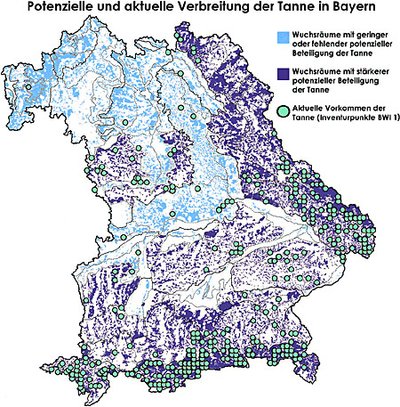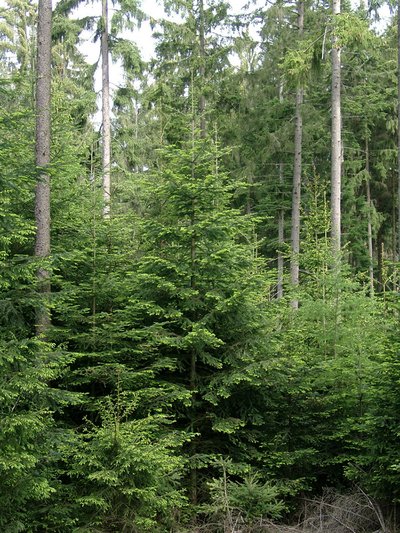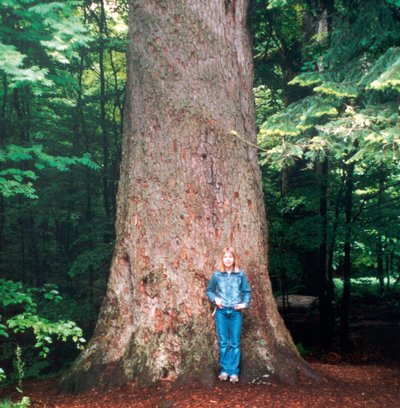The fir and the natural forest composition in Bavaria

Picture 1: distribution of the silver fir in Bavaria; potential distribution of the silver fir according to Walentowski et al. (2001); present occurrence recorded by the state forest inventory I (1986-1990).Light blue = growing spaces with a small or a missing potential participation of the fir
Dark blue = growing spaces with higher potential participation of the fir
Green = present occurrence of the fir (inventory points BWI 1)
The fir whose original habitat includes almost all forest areas in Bavaria is the conifer with the largest potential distribution by nature. But as it is typical of South Germany, firs are always associated with other tree species in Bavaria and rarely form stands on their own. As the fir is a typical admixed tree, pure stands are usually due to human influences. According to the map illustrating the natural forest composition in Bavaria, the fir should be participated in 1,4 ha of the present forest area. As predicted by the present as well as the potential distribution, the highest density is reached in the mixed mountain forests of Bavaria, the beech forest associations of the mountainous regions.
Triumph over the decline
In Bavaria, fir stands are covering an area of about 48000 ha at the moment. This is a proportion of only 2 %. The main growing spaces are the Bavarian Alps and the Bavarian Forest. Within the Bavarian State Forest, fir stands take up an area of about 15000 ha. Over 60 % of the firs are older than 100 years. A striking fact is the poor participation of the fir in 21- to 80-year-old stands. Obviously we didn’t succeed in regenerating a sufficient number of firs in the past. Besides wrong silvicultural treatment, this failure is a consequence of excessive browsing due to game stocks exceeding the tolerable size. According to an inventory about the situation of forest regeneration in 1991, about 40 % of the firs show browsing damages on the main shoots. However, the browsing situation has considerably improved during the last years. For example, in 2003, the damage of the main shoots could be observed on only 19 % of the firs, and the regeneration rate has doubled.
Shady places – the fir’s favourable sites
The fir prefers a cool, but not too cold and wet climate. That’s why, in Middle Europe, the Alps and the Highlands in South Germany offer ideal growth conditions. The fir grows on the sour sites of the Bavarian Forest as well as on calcareous soils in the Alps. A well developed tap root and several strong lateral main roots penetrate even in very dense soils and can reach a depth of about 2 m, independent of the site. Therefore the fir shows an extraordinary high stability.
Besides the macroclimate, which is crucial for the natural occurrence, the microclimate is the decisive factor for the local occurrence.
A forest climate with lots of calm in atmosphere and high air humidity supports at best the development of the fir. This is guaranteed in all-aged selective stand structures where the fir is able to develop a high crown – an important condition for vitality and productivity. In the shelter of the old forest, the fir finds very favourable ecological conditions for regeneration. The ability to hold out for years in the secondary stand with poor insolation and to join the main stand after liberation cutting is the decisive advantage over other competing trees species. Therefore, the promotion of all-aged stands as well as measures to keep the lower storey and the secondary stand in good condition are essential to ensure the maintenance and the promotion of the fir.
Tree giants – living symbols
Silver firs can reach a height up to 60 m, a diameter of over 200 cm, a volume exceeding 60 m³ and an age of about 600 years. Thus, it belongs to the most gigantic indigenous tree species. Theses days, about 400 firs older than 400 years are growing in the Bavarian State Forest. About 500 firs have a diameter of over 1 m; about 2000 firs reach an impressive height of over 45 m. The increment of the fir culminates visibly later than that of the spruce. Compared to spruce and beech, the slow juvenile growth is a striking characteristic of the fir., On comparable sites, the fir needs therefore a temporal advantage of about 20 to 30 years, eventually even of 50 years, over spruce and beech.
No fir without hunting
No other tree species depends as much on hunting conditions for regeneration and occurrence as the silver fir. In the last 150 years, the game stock has considerably increased. The fact, that the fir tends to regenerate in small numbers, turns out to be quite problematic: As a preferred tree species in game browsing, big-sized game stocks often impede a sufficient reproduction of the fir. In addition, the fir remains in the browsing zone for many years because of the slow juvenile growth. A fir wounded at the main shoot takes two years to develop a secondary compensation shoot. If other tree species with smaller browsing damage overgrow these firs, a total loss of the fir regeneration is a common consequence.
The situation improves
At the end of the 19th century, a local withering of old firs could be observed for the first time. In the 1980s, a considerable over-thinning of the crown which was firstly observed on firs, then also on other tree species, aggravated the situation. In addition, the fir suffered heavy increment losses. Crown analysis which have been carried out since 1983 finally proved that the fir is the most heavily endangered tree species in Bavaria so far. But with a proportion of 7% in the year 2003, the share of firs whose loss of needles exceed the amount of 60% has slightly decreased and none of the controlled firs has recently withered this year.
Since the sulphur pollution of the atmosphere has clearly been reduced, many firs show a visible improvement in the increment of height and diameter. There is a real hope that the reduction of the SO2-immission allows the fir to re-establish in the forests of Bavaria.
The fir – a great hope
As an admixed tree, the fir is an important element in the process of adapting our forests to the predicted climate change. Better than other tree species, it is able to cope extreme natural phenomena like droughts, hurricanes and torrents. The reason are the excellent biological characteristics of the fir: Roots penetrating extremely deep into the soil allow the fir to access water resources in the subsoil which can not be used by other tree species on sites where long-lasting dry seasons have exhausted the water supply of the top soil. That’s why the fir is a great hope and an alternative to the spruce which is especially endangered on these sites.
The fir – today more important than ever
The fir is the indigenous conifer with the largest potential. As an admixed providing stability, the fir is not only representative for a naturalistic and all-aged forest. Because of its high adaptability, it is also a great hope for the structure of tomorrow’s forest. However, adapted game stocks and a hunting attitude which is favourable to the forest are indispensable prerequisites. The reduction of the sulphur-immission and a fundamental change toward a naturalistic silviculture offer a successful future of the fir – as long as we keep supporting this idea.


